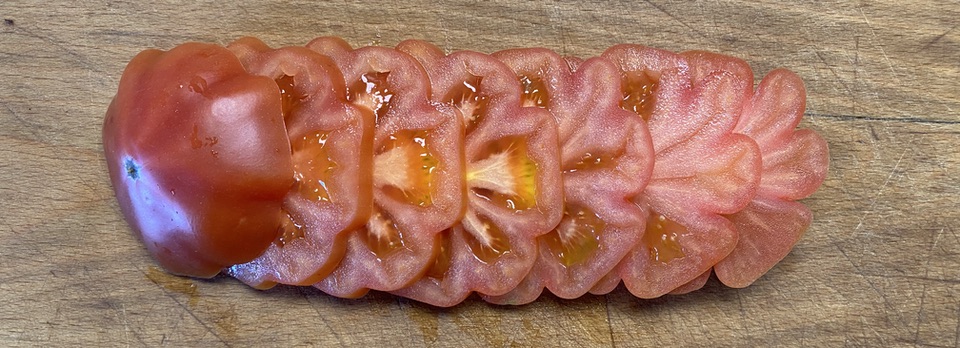
Podcast: Play in new window | Download (Duration: 18:17 — 16.9MB)
Subscribe: Google Podcasts | Spotify | Android | RSS | More

Plants of the weedy wild relatives of the tomato all look pretty much like one another, but under the surface they’re a seething mass of genetic diversity. That diversity — along with the discovery of truly wild tomatoes in Mexico — has allowed researchers to finally tell a story of tomato domestication that fits all the available evidence. In essence, people domesticated the tomato in the Amazonian areas of Ecuador and Peru, but from wild material originally from Mexico. Traditional varieties, by contrast, are a feast of diversity for the eyes; size, shape and colour vary widely, but all that morphological diversity is not mirrored in genetic diversity. In fact, modern, scientifically-bred tomatoes are more diverse than traditional varieties, and almost a quarter of so-called traditional varieties are “tainted” by modern genetics.
Jose Blanca, one of the researchers involved in these two recent discoveries, told me more about what they found and what it means.
Notes
- The two papers we talked about are Haplotype analyses reveal novel insights into tomato history and domestication driven by long-distance migrations and latitudinal adaptations and European traditional tomatoes galore: a result of farmers’ selection of a few diversity-rich loci. Jose Blanca has also written a couple of articles (in Spanish) in The Conversation.
- Here is a PDF of the transcript.
- Extra music: Matamoscas from Blue Dot Sessions.
- Banner photo by me. Cover photo adapted from Berg’s Fairytale Garden’s Instagram feed.

[…] Jeremy gets into tomato domestication and diversity on his podcast. […]
https://media.blubrry.com/eatthispodcast/mange-tout.s3.amazonaws.com/2022/orange-toms.mp3Podcast: Play in new window | Download (Duration: 20:20 — 18.7MB)Subscribe: Google Podcasts | Android | RSS | More
Since the 1960s, European seed law could best be summarised as “everything not forbidden is compulsory”. There is a common catalogue of registered seed varieties, and only varieties on the list are on sale. With a flat fee for registration, only the most lucrative varieties are registered, which suits big seed companies and tomato growers, but meant that lots of varieties with more niche appeal — for home gardeners or small growers — vanished. The law is now being relaxed a little, allowing trade in seeds of “organic heterogeneous material”. Diversity, to you and me.
Organic growers and breeders have been preparing to take advantage of their new freedom by creating new, diverse populations, funded by the same EU. I went along to a field day to evaluate the fruits of a programme to breed new varieties of orange tomatoes.
Notes
Andrea Mazzucato shares his research papers. He also works with Jose Blanca, who told me about Tomatoes: domestication and diversity in April 2022.
Rete Semi Rurali’s website in Italian.
I would love to send you to the website of the EU’s Harnesstom project, but as a result of enemy action is has been offline since September 26.
Two good sources on tomato fruit colour are from Frogsleap Farm and something called the online tomato vine.
If you are interested in seeds and plant breeding, there are plenty more episodes.
Huffduff it
Genebanks conserve at least 1089 “traditional” tomatoes; 1039 too many?
“You could have, well, maybe 99% of the genetic diversity of the traditional tomato, just by having 50 varieties.”
@jblanca42 From the transcript at eatthispodcast.com/tomatoes
Very true, although there is a huge amount of extra genetic diversity in very low frequencies. That means that few varieties will have the allele of interest, so you have to study many to get it.
Genebanks conserve at least 1089 “traditional” tomatoes; 1039 too many?
“You could have, well, maybe 99% of the genetic diversity of the traditional tomato, just by having 50 varieties.”
@jblanca42 From the transcript at eatthispodcast.com/tomatoes
Genebanks conserve at least 1089 “traditional” tomatoes; 1039 too many?
“You could have, well, maybe 99% of the genetic diversity of the traditional tomato, just by having 50 varieties.”
@jblanca42 From the transcript at eatthispodcast.com/tomatoes
Genebanks conserve at least 1089 “traditional” tomatoes; 1039 too many?
“You could have, well, maybe 99% of the genetic diversity of the traditional tomato, just by having 50 varieties.”
@jblanca42 From the transcript at eatthispodcast.com/tomatoes
eatthispodcast.com/tomatoes/
In the latest episode, Jose Blanca explains how a deep dive into tomato genetics makes sense of domestication and reveals the paradox of European tomato diversity.
eatthispodcast.com/tomatoes/
It’s been a great pleasure to talk about the history of the tomato, in America and Europe, @EatPodcast
I think many allotmenteers and back garden veg growers would be interested in the latest @EatPodcast episode on the science behind “Tomatoes: domestication and diversity”
eatthispodcast.com/tomatoes/